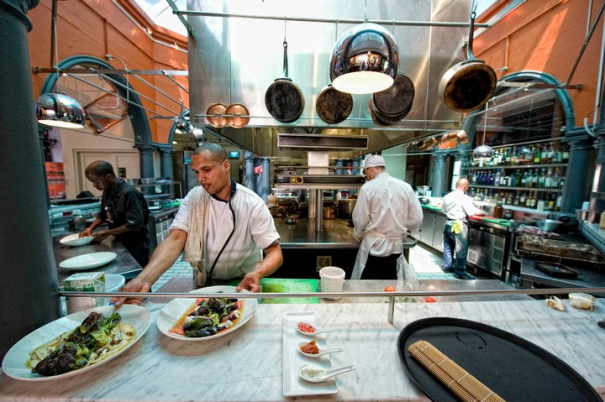Whether it was the unwilling acceptance of potatoes by 18th century peasants in Europe (they thought the spud caused leprosy) or James Allan Sharwood’s introduction of curry powder to England in the 1890s, there’s always been a bit of confusion in the evolution of cookery.
As globalisation proceeded apace, adventurous chefs didn’t merely incorporate exotic ideas and new ingredients, but attempted to marry remote culinary conventions in the hope of a serendipitous discovery. These matchups are often forced marriages that soon fall apart. Sometimes they are pure sadomasochism, such as a ginger and lemongrass crème brûlée. At other times, combinations from disparate parts of the world work so well we don’t even notice them – for instance the tamarind in Worcestershire sauce responsible for its signature flavour.
Fusion cuisine cross-pollinates the ingredients and cooking methods of the occident and the orient. Nouvelle cuisine, inspired by Japanese presentation, paved the way. Fusion dishes still tend to be of delicate proportions and deep flavours. In the 1970s, Californian chefs (Wolfgang Puck among others) were the leading exponents of the style. The Pacific Rim, particularly Australasia, came to define contemporary fusion cuisine.
Diverse, eclectic and young South Africa, which if we’re honest doesn’t have a robust gastronomic tradition worth defending, is potentially a ripe market for fusion cooking to thrive. Our gourmet establishments readily embrace the fusion philosophy.
Chefs who want to play with food in this way need considerable sagacity, otherwise the fare simply tastes like an incorrectly cooked ethnic dish. In critiquing such exogamous creations, authenticity is no guideline; harmony and balance are.
Chef Mike Basset at Myoga (who opened Ginja ten years ago) seems to be taking the lead locally in fusion cuisine, making it the underpinning tenet of his kitchen. Myoga’s reputation has risen rapidly since its first season in 2008.
Myoga is an edible flower of the ginger family, and the blossom forms the decorative motif on the carpets in this elegant and spacious 100-seater room. The property was once part of Lady Anne Barnard’s country house. Centre, is a large open-plan kitchen that is disconcertingly calm. Don’t leave without visiting the toilets. LED screens above the urinals have live closed-circuit cameras trained on the kitchen.
I dined at Myoga anonymously before, once with a table of ten. This time it was by invitation to experience their newly-launched menu.
There is a limit to what South Africans are prepared to spend on a dining experience and its faraway less than in comparable establishments overseas. Yet quality produce costs almost the same. The past year was grim for restaurateurs. Bassett has responded with courage. Some Capetonians take offence at the incredible winter specials offered by our posh restaurants, seeing them as sops to the local market whose custom is spurned during the season when maître d’s are too busy fawning over wealthy tourists. Such allegations won’t stand at Myoga for what was a special is now a permanent feature: R150 for six-courses with five options per course. I love this kind of dining.
Sure, the first course is essentially an amuse-gueule, the fourth a sorbet, and a few choices have surcharges, but it’s indisputably terrific value. I feel like a hamster let loose on a tasting wheel. The portions are judicious, but vraats will grumble.
The affable and knowledgeable sommelier Carl Heinz Habel will pair the food with wine (R150 if you start with a flute of Simonsig Kaapse Vonkel).
Begin with an oyster and a thimble of granita (grainy Italian-style iced water) which hits you first with intense lemon and finishes with a Tabasco burn on the epiglottis, or try the prawn on a skewer standing in a shot glass of sweet chilli and coriander foam. The goats cheese jalepeño samoosa with mango salsa and coriander is a nifty take on the old pastry triangle.
Soup follows. The Cape seafood bouillabaisse is now off the menu (and won’t be missed), but unfortunately so is the garden pea and pancetta potage. The new duck miso with carrot chiffonade, shitake mushrooms, dashi (Japanese soup stock), shoga shavings (ginger) and shichimi togarashi (a 7-spice blend) is despite its many ingredients docile; the Bouchard Finlayson Blanc de mer 2009 overpowered the dish. Not so with the smoked tomato cream soup dissolving beads of basil gelato. Its smokiness overwhelmed not only the dish, but the whole table.
The third course is pasta. Previously, the potato gnocchi was basking in so much rich tomato butter one had to ask for more bread. The gnocchi now is served with smoked pumpkin, sage butter and truffle cream. True fusion success comes with the cannelloni (crêpe style) and roast chicken in hoisin (a Chinese sweet and spicy, red sauce made from soya beans) and soubise (a classic French onion sauce with a béchamel base). The result is redolent of a velvety gourmet pie filling. A wooded Tokara Chardonnay further amplifies the flavours. But choice is the Asian noodle salad with prawns, avocado, toasted peanuts, fresh mint, basil, and chilli lime dressing.
In addition to three fruit sorbets, Bassett has added honey-ginger and jasmine tea. The ginger tea is reviving, but doesn’t reset the palate.
For mains, you can’t go wrong with either the chef’s previous or his current more elaborate take on roasted pork belly, with potato puree, honey glazed apple, kumara (sweet potato) and kung poa (a Szechuan sauce), complimented with a spry Beyerskloof Pinotage 2007 Reserve.
For desserts, I will miss the wobbly vanilla panna cotta, but can recommend the petite 60g camembert round from Dalewood, lightly roasted, with caramelised walnuts, fig preserve and a glass of Joostenberg botrytis wine.
I do hope Bassett’s strategy of high turnover on thin margins pays off. Myoga deserves to be full every night.
Myoga, Vineyard Hotel, 60 Colinton Road, Cape Town. Tel: 021 6574545.

